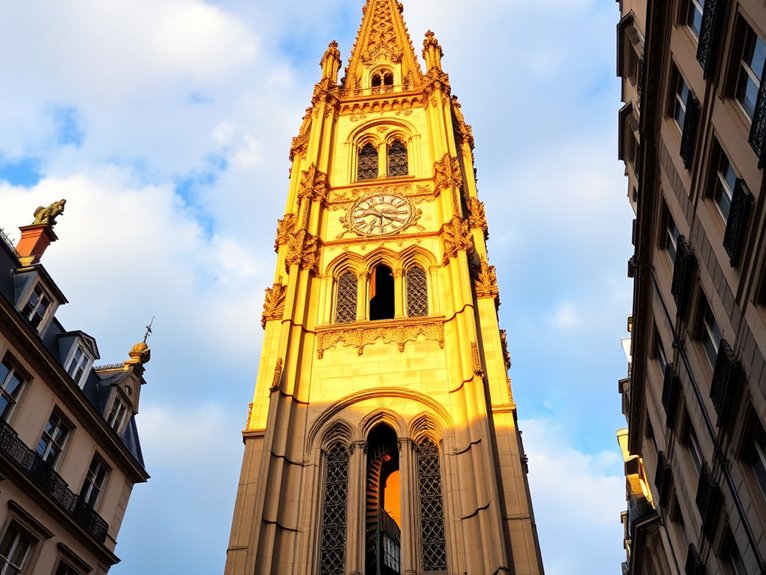
7 Unique Clock Towers in Paris Open for Visits
I've discovered seven magnificent clock towers you can visit in Paris! The Gothic Saint-Jacques Tower rises 52 meters with its astronomical clock, while the Belle Époque Gare de Lyon tower stands proudly at 67 meters. Don't miss Saint-Paul-Saint-Louis's octagonal beauty, the Sorbonne's timekeeper, Conciergerie's Tour de L'horloge, Saint-Germain-l'Auxerrois's historic bells, and Mairie Du 1er's hidden gem. Each tower offers unique architectural wonders and fascinating stories waiting to be explored.
Saint-Jacques Tower: A Gothic Masterpiece in the Heart of Paris
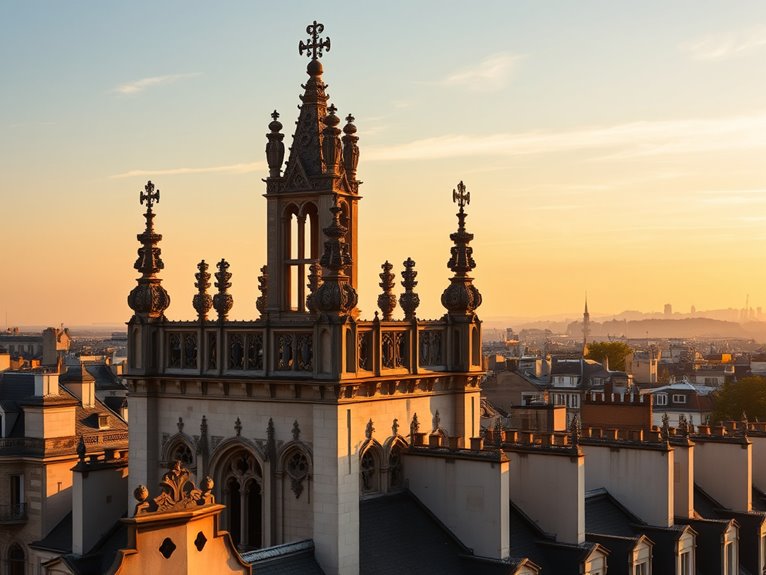
Standing alone in a small square in Paris's 4th arrondissement, the Saint-Jacques Tower rises majestically as a remarkable representation of French Gothic architecture. This 52-meter-tall tower, the only remaining vestige of the former Church of Saint-Jacques-de-la-Boucherie, has witnessed centuries of Parisian history since its construction in the early 16th century. Its intricate stone lacework, dramatic gargoyles, and astronomical clock make it an architectural marvel that often goes overlooked by tourists focused on more famous landmarks.
The tower's historical significance extends beyond its architectural beauty, as it served as an important stopping point for pilgrims traveling the Way of Saint James to Santiago de Compostela. Today, the restored monument offers visitors a unique perspective on medieval Paris, featuring elaborate sculptures of saints, symbolic animals, and the figure of Saint James himself, while also housing a meteorological station established by scientist Nicolas Houel in 1891.
Quick Facts:
- Opening Hours: Tuesday to Sunday, 10:00 AM – 5:30 PM (closed Mondays)
- Best Visit Time: Early morning or late afternoon for prime lighting
- Entry Fee: €10 for adults, free for under 18
- Photography: Best shots from Square de la Tour Saint-Jacques
- Guided Tours: Available in French and English
- Climbing Access: Limited to guided tours only
- Seasonal Operation: Open April through October
- Physical Requirements: 300 steps to climb, no elevator
The Tower Experience:
The Saint-Jacques Tower offers guided tours that take visitors up 300 steps to various levels, each providing unique perspectives on both Gothic architecture and Paris's cityscape. The spiral staircase leads to multiple platforms where visitors can examine detailed sculptures up close and learn about the tower's astronomical functions. Insider tip: The third-floor platform features little-known medieval mason marks, providing insight into the tower's construction techniques.
Architectural Details:
The tower showcases some of the finest examples of Flamboyant Gothic style, with intricate stone carvings depicting religious scenes, mythical creatures, and botanical motifs. The statue of Saint James at the tower's summit is accompanied by symbolic animals representing the four evangelists. Little-known fact: The tower's western face contains a hidden medieval sundial that still accurately tells time.
Pro Tips:
For the best photographic opportunities, visit during "golden hour" just before sunset when the sun's low angle illuminates the intricate stonework dramatically. Book guided tours at least two weeks in advance during peak season (July-August), and consider visiting on weekday mornings when groups are smaller. The tower's location near the Châtelet-Les Halles transportation hub makes it easily accessible, but many visitors miss the small entrance on the north side of the square.
Practical Advice:
Wear comfortable shoes with good grip for the stone stairs, and bring a water bottle as there are no facilities inside the tower. Photography is permitted throughout the climb, but tripods are not allowed due to space constraints. Consider combining your visit with exploration of the nearby Marais district or the Centre Pompidou, as the tower tour typically takes about 90 minutes to complete.
The Clock Tower of the Gare De Lyon
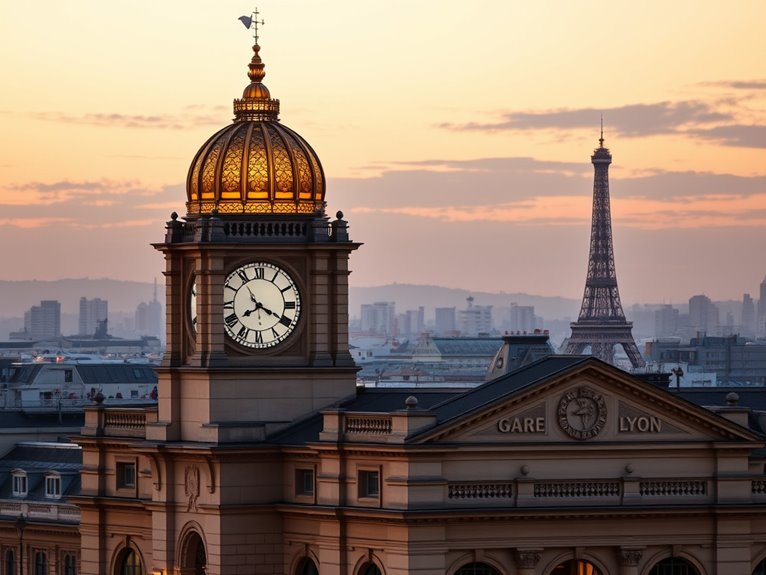
Standing proudly above one of Paris's major railway stations, the Clock Tower of the Gare de Lyon represents a masterpiece of 19th-century architectural design and timekeeping precision. This iconic landmark, completed in 1900 for the World's Fair (Exposition Universelle), combines functional railway architecture with the elegance of the Belle Époque period, featuring a magnificent four-faced clock that has guided travelers for over a century.
The 67-meter-tall tower not only serves as a temporal beacon for hurried commuters but also houses one of Paris's most prestigious restaurants, Le Train Bleu, making it a unique intersection of transportation history, architectural beauty, and French gastronomy. Visitors can admire the tower's intricate stonework, its perfectly preserved mechanical clock system, and experience a slice of Parisian railway heritage that continues to play a crucial role in modern city life.
Quick Facts:
- Best viewing times: Dawn and dusk for ideal photography
- Access: Free to view exterior; restaurant requires reservations
- Photography tips: Best angles from Place Louis-Armand
- Opening hours: Station open 4:30 AM – 1:30 AM daily
- Historical significance: Built for 1900 World's Fair
- Clock faces: Four sides, each 6.4 meters in diameter
- Architectural style: Belle Époque
The Clock Tower Experience:
The tower's architectural design showcases classic French style with its limestone façade, ornate decorative elements, and perfect proportions. Visitors can access the base of the tower through the main station concourse, where detailed informational panels explain its history and construction. The mechanical clock system, maintained regularly by SNCF technicians, represents one of the few remaining original station clock mechanisms still in operation in France.
Pro Tips:
For the best photography opportunities, visit during the golden hour when the setting sun illuminates the western clock face. Consider combining your visit with lunch or dinner at Le Train Bleu restaurant, but book well in advance – especially for dinner service. The restaurant offers a unique vantage point of the station's architecture and a glimpse into the Belle Époque era's grandeur.
Practical Advice:
The Gare de Lyon remains one of Paris's busiest stations, so plan your visit during off-peak hours (10 AM-4 PM) to avoid the largest crowds. The station has multiple entrances, but the entrance on Place Louis-Armand offers the best initial view of the clock tower. Keep in mind that security measures are in place throughout the station, and photography may be restricted in certain areas. For those interested in the technical aspects of the clock, guided tours are occasionally available through the Paris Tourism Office, though advance booking is essential.
Saint-Paul-Saint-Louis Church Tower
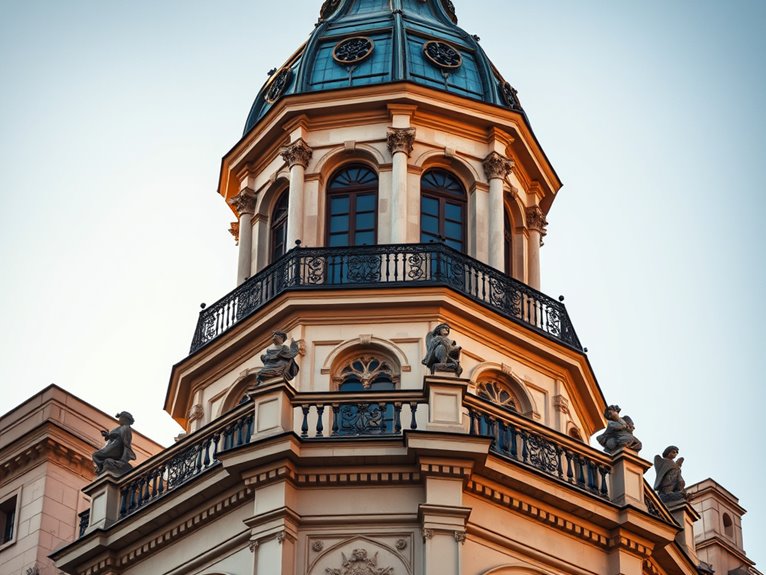
The Saint-Paul-Saint-Louis Church Tower stands as one of Paris's most distinctive Baroque architectural landmarks, featuring a remarkable clock mechanism that has kept time for the Marais district since the 17th century. Rising above the historic church commissioned by Louis XIII and completed in 1641, the tower represents a fascinating blend of religious architecture and municipal timekeeping.
The tower's unique octagonal design and its prominent position make it a striking landmark visible from various vantage points throughout the Marais. Beyond its timekeeping function, the tower has witnessed centuries of Parisian history, from the French Revolution to modern times, surviving various historical upheavals while maintaining its original character and purpose.
Quick Facts:
- Viewing Hours: 9:30 AM – 7:00 PM (tower exterior visible 24/7)
- Best Photography Time: Early morning or late afternoon for ideal lighting
- Admission: Free to view exterior; church interior visits during mass times
- Location: 99 Rue Saint-Antoine, 4th arrondissement
- Transportation: Metro stations Saint-Paul (Line 1) or Bastille (Lines 1, 5, 8)
- Photography Tips: Best angles from Rue Saint-Antoine or Rue de Rivoli
Architectural Significance:
The tower stands 60 meters high and features a distinctive combination of classical French Baroque elements with Italian influences. The clock face, decorated with gilded numerals and hands, is surrounded by intricate stone carvings depicting religious motifs. The tower's unique octagonal shape allows it to be visible from multiple angles throughout the neighborhood, making it an important navigational landmark for centuries.
Clock Mechanism:
The original clock mechanism, dating from the 17th century, has been carefully maintained and restored over the years. While the current mechanism is modern, it preserves the historical accuracy and precision that made the tower an essential timekeeper for the neighborhood. An often-overlooked detail is the small sundial on the tower's southern face, which served as a backup system for time verification.
Pro Tips:
For the best photographic opportunities, visit during the "golden hour" just before sunset when the western light illuminates the clock face and stone details. Consider bringing a telephoto lens to capture detailed shots of the clock mechanism and architectural elements. The least crowded times for viewing are typically weekday mornings, allowing for unobstructed views and peaceful contemplation of the tower's details.
Practical Advice:
When visiting the Saint-Paul-Saint-Louis Church Tower, combine your visit with exploration of the surrounding Marais district. The area features numerous historic buildings, museums, and cafes. Remember that while the tower's exterior is always visible, interior church visits should be planned around religious services to facilitate respectful access. The nearby Place des Vosges offers excellent opportunities for additional architectural photography and a perfect spot to rest while admiring the neighborhood's historical ambiance.
Sorbonne's Historic Timekeeper
Standing proudly atop the historic Sorbonne University building, the iconic clock tower has been marking time for Parisian scholars and citizens since the 17th century. This architectural masterpiece combines Gothic and Renaissance elements, serving as both a functional timepiece and a symbol of France's prestigious academic heritage.
The tower's prominence in the Latin Quarter makes it an essential stop for architecture enthusiasts and history buffs alike. Its intricate mechanisms, restored multiple times throughout history, continue to maintain accurate time while preserving the craftsmanship of centuries past. The clock face's ornate design and gilt details reflect the grandeur of French academic tradition.
Quick Facts:
- Best viewing times: Early morning or late afternoon for ideal lighting
- Access: External viewing only (university interior restricted)
- Photography tips: Zoom lens recommended for detail shots
- Location: 5th arrondissement, Latin Quarter
- Notable features: Original 17th-century clockwork mechanism
- Historical significance: One of Paris's oldest functioning clock towers
The Exterior View
The clock tower rises 50 meters above street level, featuring elaborate stone carvings and gargoyles typical of French Gothic architecture. The clock face itself spans 3 meters in diameter, with gold-leafed Roman numerals and ornate hands. While the tower isn't open to the public, the best viewing spot is from Place de la Sorbonne, where visitors can appreciate the full façade of the historic university building.
The Mechanism
Though hidden from public view, the tower houses one of Paris's most remarkable timepieces. The original mechanism, designed by master clockmaker Jean-André Lepaute, has been carefully maintained and upgraded over centuries while preserving its historic character. An insider tip: visit during the hour change to hear the unique tone of the bell, which differs from other Parisian clock towers due to its specific bronze composition.
The Historical Context
The tower was commissioned by Cardinal Richelieu as part of his grand vision for the Sorbonne's renovation. It has witnessed countless historical events, from the French Revolution to the student protests of 1968. Little-known fact: during World War II, the clock's hands were deliberately misaligned to confuse occupying forces.
Pro Tips:
The best photographs can be captured during the "golden hour" just before sunset, when the western light illuminates the clock face dramatically. For the clearest views without tourist crowds, visit early on Sunday mornings when the surrounding cafés are just opening. Consider bringing binoculars to appreciate the intricate details of the carved figures and clockwork.
Practical Advice:
While visiting the Sorbonne's clock tower, combine your trip with exploration of the Latin Quarter's other historical sites. The area around the Sorbonne is known for narrow streets and limited parking, so arriving by Metro (Luxembourg or Cluny-La Sorbonne stations) is recommended. Remember that the university building is still active, so respect quiet zones and academic activities during your visit.
Tour De L'horloge at the Conciergerie
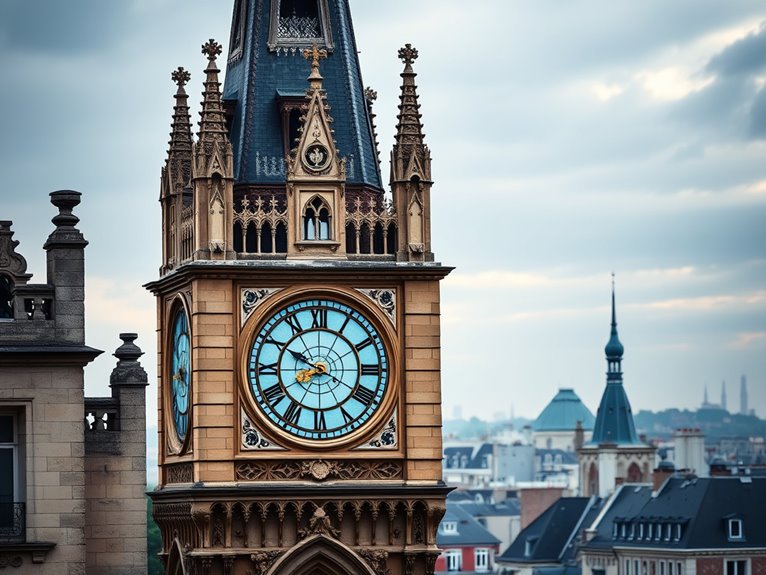
Standing majestically on the corner of the Conciergerie, the Tour de l'Horloge represents one of Paris's most significant medieval timepieces and architectural achievements. This remarkable clock tower, installed in 1370 under the reign of Charles V, holds the distinction of being Paris's first public clock and continues to captivate visitors with its ornate decoration and historical significance.
The tower's stunning facade features intricate sculptural elements, including allegorical figures representing Law and Justice, while its iconic timepiece combines practical functionality with artistic excellence. The blue and gold clock face, restored to its original glory, serves as a demonstration of medieval craftsmanship and stands as a symbol of Paris's technological advancement during the Middle Ages.
Quick Facts:
- Best visiting hours: 9:00 AM – 6:00 PM (Wednesday through Monday)
- Entry fee: Included with Conciergerie admission (€9.50 for adults)
- Photography: Exterior photos permitted anytime; interior restricted
- Location: 2 Boulevard du Palais, 75001 Paris
- Accessibility: Limited mobility access available
- Guided tours: Available in multiple languages (book in advance)
The Tour de l'Horloge's most distinctive feature is its elaborate clockwork mechanism, which has been maintaining time for over six centuries. While the current mechanism dates from the 19th century, it follows the same principles as the original medieval installation. The clock face itself underwent a complete restoration in 2012, revealing its original blue background and golden fleur-de-lis decorations. Insider tip: Visit during the first hour of opening to catch the morning light illuminating the clock face, creating stunning photo opportunities.
Pro Tips:
The best views of the Tour de l'Horloge can be captured from the Pont au Change bridge, particularly during golden hour (approximately one hour before sunset). For architecture enthusiasts, visiting on a clear day between 2:00 PM and 4:00 PM offers ideal lighting conditions to observe the sculptural details. Consider combining your visit with a tour of the adjacent Conciergerie to maximize your historical experience and understand the tower's context within Paris's medieval judicial system.
Practical Advice:
When planning your visit, be aware that the area around the Tour de l'Horloge can become crowded, especially during peak tourist season (June-August). The tower is easily accessible via Metro lines 4 and 1 (Cité station) or RER B and C (Saint-Michel Notre-Dame station). Purchase tickets online to avoid queues, and consider visiting during shoulder season (March-May or September-November) for a more relaxed experience. Photography enthusiasts should bring wide-angle lenses to capture the tower's full height from nearby vantage points.
Saint-Germain-l'Auxerrois Bell Tower
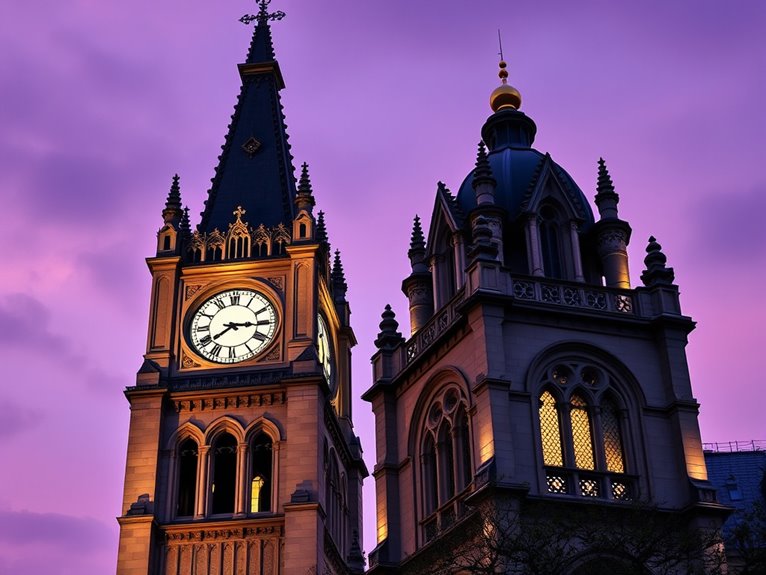
The Saint-Germain-l'Auxerrois Bell Tower stands as one of Paris's most historically significant timepieces, commanding attention alongside the Louvre Museum. This remarkable Gothic structure, dating back to the 13th century, gained infamy during the St. Bartholomew's Day Massacre of 1572 when its bells signaled the beginning of the tragic event, forever marking its place in French history.
Beyond its darker historical moments, the bell tower represents a masterpiece of French Gothic architecture, featuring intricate stone carvings, dramatic pointed arches, and a mechanical clock that has kept time for centuries. Visitors to this architectural marvel can explore both its exterior grandeur and, during select times, its interior, offering unique perspectives of Paris and insights into medieval timekeeping.
Quick Facts:
- Best visiting hours: 10:00 AM – 4:00 PM, Tuesday through Sunday
- Photography: Early morning light best for exterior shots
- Access: Free exterior viewing; interior visits by guided tour only
- Located: 2 Rue du Louvre, 75001 Paris
- Best viewing season: Spring and Fall for ideal lighting and fewer crowds
- Accessibility: Limited for mobility-impaired visitors
The bell tower's most distinctive feature is its original 16th-century clock mechanism, which continues to function today. The tower rises 40 meters high, offering views of the Louvre's courtyard and the Seine River. Visitors can access the church grounds daily, though interior tower access requires advance booking through the Paris Historical Society.
Pro Tips:
For the most atmospheric experience, visit during the quarter-hour strikes when the bells toll. Photographers should position themselves at the corner of Rue de l'Arbre Sec and Rue de Rivoli for the best unobstructed views of the tower against the backdrop of the Louvre. During summer months, evening lighting creates dramatic shadows perfect for architectural photography.
Practical Advice:
Combine your visit with a tour of the adjacent church of Saint-Germain-l'Auxerrois and the Louvre Museum. The area can get extremely crowded during peak tourist season (June-August), so early morning visits are recommended. Street parking is limited, so using public transportation (Metro: Line 1, Louvre-Rivoli station) is advised. Consider downloading the Paris Monuments app for detailed historical information and audio guides available in multiple languages.
The Hidden Clock Tower of Mairie Du 1er

Tucked away in the heart of Paris's 1st arrondissement, the clock tower of Mairie Du 1er stands as a symbol of the city's architectural ingenuity and historical preservation. Unlike its more famous counterparts, this hidden gem offers visitors a unique glimpse into the administrative heart of Paris's oldest district while showcasing remarkable 19th-century clockwork mechanisms that continue to keep time for locals and visitors alike.
This lesser-known clock tower, dating back to 1857, represents a perfect blend of functional municipal architecture and artistic design. While tourists flock to Notre-Dame and Sacré-Cœur, the Mairie Du 1er's tower provides an intimate and authentic Parisian experience, complete with intricate mechanical systems and stunning views of the surrounding neighborhood from its observation points.
Quick Facts:
- Best visiting hours: Tuesday-Saturday, 10:00 AM – 4:00 PM
- Admission: Free (guided tours by appointment)
- Photography: Permitted, tripods allowed during guided tours
- Access: Limited mobility access available with advance notice
- Location: 4 Place du Louvre, 75001 Paris
- Tour duration: Approximately 45 minutes
The clock tower's mechanical heart consists of an impressive array of gears, weights, and pendulums that have kept time for over 160 years. The original mechanism, crafted by renowned clockmaker Armand-François Collin, remains largely intact and operational. Visitors can observe the intricate workings during guided tours, which are offered in both French and English. An insider tip: Request to see the rarely-shown maintenance logbooks, which contain fascinating historical notes dating back to the tower's construction.
The tower's architecture seamlessly integrates with the Mairie's neoclassical façade while incorporating unique design elements that set it apart from other Parisian clock towers. The four clock faces, each measuring two meters in diameter, feature hand-painted numerals and gilded hands that have been restored to their original splendor. The observation level, accessible via 87 spiral steps, provides unexpected views of the Louvre's rooftops and the Saint-Germain l'Auxerrois church.
Pro Tips:
The best time to photograph the tower is during the golden hour, just before sunset, when the western light illuminates the clock faces dramatically. For the most immersive experience, schedule your visit to coincide with the weekly winding of the mechanism, which typically occurs on Wednesday mornings. The maintenance staff occasionally allows visitors to participate in this ritual, though this must be arranged in advance through the Mairie's cultural office.
Practical Advice:
While the tower is open year-round, winter visits require warm clothing as the mechanism room is not heated to protect the historic equipment. Book guided tours at least two weeks in advance through the Mairie's website or cultural office, and be prepared to show identification upon arrival. Photography enthusiasts should bring fast lenses for the dimly lit mechanism room, as flash photography is prohibited to protect the historic equipment and decorative elements.
